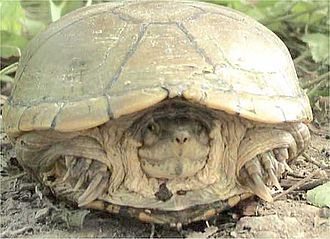| Place of Origin and Range |
Found in Mexico: Chihuahua, Coahuila, Nuevo León and Tamaulipas, and the United States: Arizona, Colorado, Illinois, Iowa, Kansas, Missouri, Nebraska, New Mexico, Oklahoma and Texas. |
| Description |
The yellow mud turtle is a small, olive-coloured turtle. Its name comes from the yellow coloured areas on its throat, head and on the sides on its neck. The bottom shell is yellow to brown with two hinges, allowing the turtle to close each end separately. The male's tail has a blunt spine on the end, but the female's tail does not. |
| Morph Patterns Available |
Yes |
| Adult Size |
Can grow up to 5.5in(14cm) |
| Accommodation |
A filtered aquarium with water temperature at 70-80'F(21-26'C), and a sloping ramp(driftwood, textured plastic or some other non-abrasive surface) leading from the bottom to an illuminated and warmed basking spot. Approx 80'F(27'C). |
| Lifespan |
Can live up to 15 years. |
| Feeding / Diet |
Their diet includes worms, crayfish, frogs, snails, fish, fairy shrimp, slugs, leeches, tadpoles, and other aquatic insects and invertebrates. They also eat vegetation and dead and decaying matter. |
| Breeding |
Most female aquatic turtles excavate a nest in the soil near a water source, deposit their eggs and leave, but yellow mud turtles exhibit a pattern of parental care. They are the only turtle that has been observed that stays with the eggs for any period of time. The female lays a clutch of 1-9 eggs and stays with the eggs for a period of time of a few hours up to 38 days. It is believed that the female stays to keep the predators away from the eggs. It was also observed that the females would urinate on their nests in dry years. This is believed to aid in the hatch success rate of the eggs in dry years. |
| Other Considerations |
Watch for theses health concerns carefully with your turtle. Vitamin A Deficiency: Vitamin A is an important nutrient for your turtle’s health. It is found in his diet in the form of leafy green, orange or yellow vegetables, liver, and fish. If your turtle is not getting enough Vitamin A, he can suffer serious health problems. Always check to make sure that your turtle does not have swollen eyelids, as this is the main sign of a Vitamin A deficiency. Also, check for weight loss, nasal discharge and infected skin. Any of these symptoms could point to a deficiency. If you think your turtle may not be getting enough Vitamin A, you should take him to the veterinarian to get a firm diagnosis. Shell Problems: Your turtle’s shell is very important to his overall health. There are many potential problems that could occur, so you should be on the lookout at all times. Respiratory Disease: Respiratory infections have symptoms similar to vitamin A deficiency, including swollen eyelids and runny nose, so you should take your turtle to the veterinarian to get a proper diagnosis if you suspect either. More serious infections will be characterized by breathing through the mouth, mucus in the mouth, and wheezing. Always make sure your turtle’s environment has the proper amount of humidity, as this will help prevent respiratory problems. |




